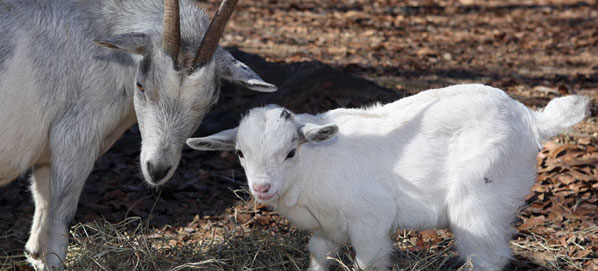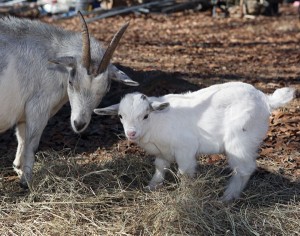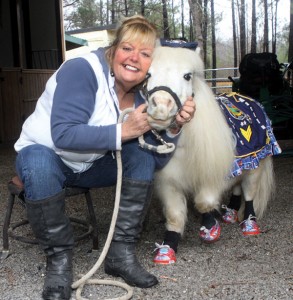
Bigger is never better for
several St. Clair farms
 Story by Elaine Hobson Miller
Story by Elaine Hobson Miller
Photos by Jerry Martin
Did you hear the one about the horse wearing tennis shoes?
No, that’s not the first line of a joke. It’s a reality for folks who have seen Jelly Bean, a miniature horse owned by Odenville’s Dana Dowdle. Once a greeter at Pell City’s Home Depot, Jelly Bean visits schools, nursing homes and hospitals, wearing the tennis shoes to keep him from slipping on slick floors.
One might think that Jelly Bean is a novelty, but this tiny prancer isn’t the only miniature animal around these parts. Ken and Donna Hale of Ashville raise miniature brahmas, or zebus, while Susan and Al Maddox of Springville have miniature goats.
With the exception of miniature horses, which can’t carry riders weighing more than 70 pounds, you can do just about anything with the little fellows that you can with their full-size counterparts. You can show them, train them to pull carts and do tricks, or simply sit and watch them romp around your yard. They take up less space than the standard versions and eat less, too. Their primary appeal, however, seems to be the cuteness factor.
Standing just 26 inches tall from bare hoof to the top of his withers, Jelly Bean is a micro-miniature horse who weighs about 100 pounds and thinks he’s a dog. “He lives in our barn, but romps through the yard like a dog,” says owner Dana Dowdle. “If he could, he would bark.”
He prefers dog biscuits and French fries to apples and carrots and rides in the back seat of Dowdle’s pick-up truck, sticking his head out the window when they go through fast-food drive-through lanes. He was the first miniature horse in Alabama to be certified as a service animal by Hand in Paw, a non-profit organization that provides animal-assisted therapy to children and adults with mental, physical, emotional and educational needs.
 Dowdle’s brother, who died in 2011, raised miniature horses with the idea of training them as service animals. He gave her Jelly Bean in 2002, right after the horse was born. Dowdle took him into her house, cuddled him and rocked him like a baby, which helped to gentle him. She put diapers on him and made him underwear, because she was “too lazy to go through the house training process.” She has worked with several service minis over the past 10 years, but Jelly Bean is the only one that is certified.
Dowdle’s brother, who died in 2011, raised miniature horses with the idea of training them as service animals. He gave her Jelly Bean in 2002, right after the horse was born. Dowdle took him into her house, cuddled him and rocked him like a baby, which helped to gentle him. She put diapers on him and made him underwear, because she was “too lazy to go through the house training process.” She has worked with several service minis over the past 10 years, but Jelly Bean is the only one that is certified.
“My brother made a ramp for him to climb up into my truck, and I made him outfits for different occasions,” Dana says. “He has a Bob the Builder outfit, a Scooby-Doo outfit, baseball and police uniforms and holiday outfits as well.”
Jelly Bean participates in Christmas parades and serves as a mascot for the St. Clair County Humane Society, the Moody Miracle League and the Margaret Police Department, where he is an honorary sergeant.
During the six years that Dana worked as a greeter at Home Depot, he often accompanied her to work. He’s so tiny, people sometimes mistake him for a goat. “Even though he’s a stallion, he’s very sweet and gentle,” says Dowdle, who is known as Jelly Bean’s mom.
Her helper at these events is 17-year-old Krissy McCarty, who gets credit from the Key Club at Springville High School for assisting Dowdle. “She helps by standing close to Jelly Bean, in case kids run up to him and spook him,” Dowdle says. “So far, he has never had a problem, but it’s nice to be prepared.”
Dowdle has trained Jelly Bean to bow, rear up and to lie down so children can pet him. She figures he has another 10-15 years of service left. “I’m doing this in memory of my daughter, Mandy, who died at the age of 4 from cystic fibrosis, and for all the mothers who are going through what I went through with her,” she says. “But I’m also happy that we could carry out my brother’s dream.”
MINIS HAVE LONG HISTORY
The result of 400 years of selective breeding, miniature horses draw on the blood of English and Dutch mine horses brought to the U.S. in the 19th century and used in Appalachian coal mines as late as 1950. They also draw upon the blood of the Shetland pony. It’s almost impossible to know how many minis are in this country, though, because many are unregistered pets in people’s backyards.
“All minis are not registered through us or other registry organizations,” says Stephanie Haselwander, events and promotions director for the American Miniature Horse Association (AMHA) in Alvarado, Texas. “We register minis that are 34 inches and smaller, measured at the last hairs of the mane. Right now, we have over 213,000 in our database. And that number doesn’t tell us much, since some of those horses could have been registered with us and died.”
TINY BRAHMAS TURN HEADS
Apparently, it isn’t quite as difficult to determine the number of miniature Brahma cows in this country. According to the website www.drdoolittle.net, there are just 2,000 registered zebus in the whole U.S.
In a normal week, eight to 10 strangers will stop by Ken and Donna Hale’s farm on U.S. 231 to look at their zebus, and four will come back and buy one. Most people just want them as pets, but the Hale zebus are registered and can be used as show animals. They can also supply beef.
“Some people look at me like I’m a cannibal when I talk about eating them, but a 400-pound bull will yield about 200 pounds of meat, enough to last most families all year,” says Ken Hale. “Zebu meat has less cholesterol than the meat of bigger cows, and their milk has a higher butterfat content — 8 percent — than the milk of larger Brahmas.”
Zebus top out at 42 inches, measured at the withers, and weigh 300-600 pounds when fully grown. Hale has always loved Brahmas, but claims he is too chicken to deal with the standard variety, which can reach 6 feet in height and weigh around 2,000 pounds. He found the first stock for his herd in Athens, Georgia, via an Internet search. He purchased four — two brood cows and two young heifers named Miss Peaches, Bonnie, Millie and Sara, respectively — in April 2011.
“They are one-person animals,” Hale says. “They will eat out of my hand, but crowd around my wife, Donna, who is the brains of our operation. Sara will nuzzle her and put her head on Donna’s shoulders. Three of the smaller calves will lie down with their heads in my wife’s lap. Yet they run from strangers.”
Despite their gentleness, they are animals that have horns when they are grown and know how to use them. “A momma gored my brother when he tried to pick up her calf,” Hale says.
They are easy to raise, requiring only half an acre per animal and about one to one-and-a-half pounds of feed daily. A standard-size cow needs 15-20 pounds of feed per day. Unlike large cows, their hooves must be trimmed regularly. They breed late, starting at the age of 3, and weigh about 15-16 pounds at birth.
“They look like fawns when they are born, and their mommas hide them,” Hale says. “Like fawns, if they’re under a clump of fescue, the calves won’t move. So unless you step on them, it’s hard to find them. I have to go hunting them down.”
But they grow fast, doubling in size in their first three months. They get more docile as they get older and are sometimes used in youth rodeos. “They can live up to 25 years, and most people keep them until they die, unless they’re raising them for food,” Hale says. “They’re nothing but muscle.” They are primarily gray in color, but also come in black, red, spotted or almost pure white.
Raising zebus is a business for the Hales, but the business brings them lots of pleasure. “I’m handicapped, I have emphysema, and I’m on a breathing machine,” Hale points out. “It’s so rewarding to go out to the pasture in my wheelchair and feed ‘em and watch ‘em eat and play. The calves are so much fun. It’s almost like watching a Norman Rockwell movie.”
GOT HER (DWARF) GOAT
That’s the way Susan Maddox feels about the Nigerian dwarf goats she and husband, Al, raise at their Old Farts Farm on US 11 in Springville. When Susan gets tired of feeding her chickens, peacocks, ducks, rabbits, pigeons, quail, alpacas and miniature horses, she goes and sits in the goat pen, and all is right with the world.
And despite the fact that Al didn’t want Susan to buy any dwarf goats in the first place, he often gets down on his hands and knees in their pen and lets them crawl on his back. “I’m their play-pretty,” he says.
Nigerian dwarf males get up to 28 inches in height, females 26 inches, according to Tara Maynard, who helps the Maddoxes with their farm chores. “Larger than that, they’re considered pygmies, not dwarfs,” she says. “Even though they’re little, dwarfs can supply enough milk for a small family daily.”
The Maddoxes have to buy food made especially for dwarfs, because the feed made for larger goats contains too much copper for their tiny systems. The dwarf nannies give birth once a year, and have one kid the first time and twins or triplets after that. So the Maddoxes usually have 12-15 dwarf goat babies every year. They weigh from one to two pounds at birth, and although they raise them to sell, sometimes Susan finds it hard to part with one. “Sometimes I cry, and the buyer feels guilty,” she admits.
Most people buy them for pets, but occasionally someone wants them for meat. Susan can tell the difference, and usually discourages meat-buyers by jacking up the price. “I normally get $75-$100 for a dwarf, but if I suspect they want to eat it, I’ll ask $500.”
As with all their animals, the Maddoxes put a lot of time into raising the dwarf babies. “We handle them and gentle them from the time they’re born,” she says. “I spoil ‘em. They’re no trouble to care for. If you ever get any, you’ll find yourself sitting out in the pen, just watching them play.”
For an additional story on Llamas in St. Clair, check out this month’s edition of Discover The Essence of St. Clair
































